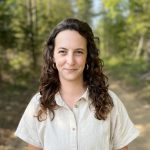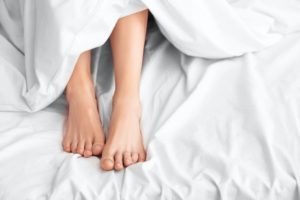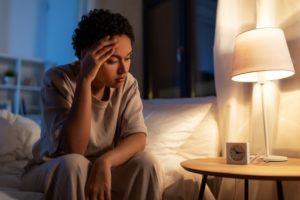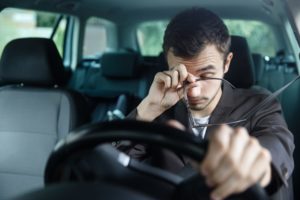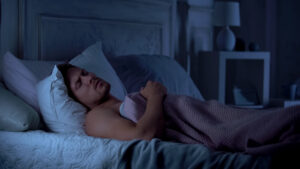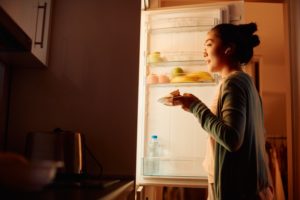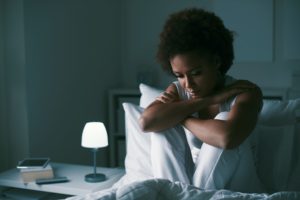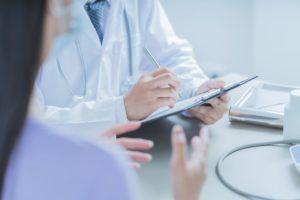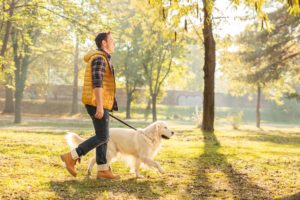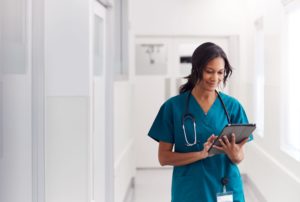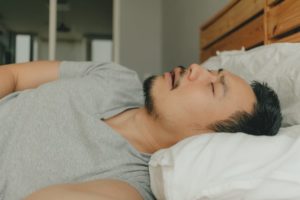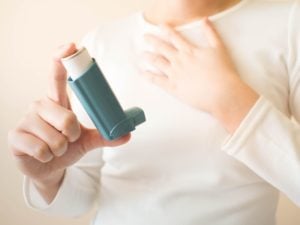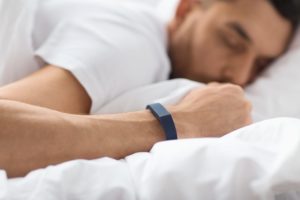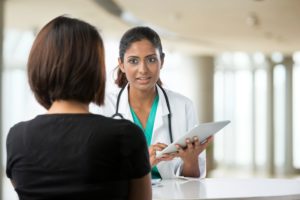When you buy through our links, we may earn a commission. Products or services may be offered by an affiliated entity. Learn more.
Catathrenia: Why Do I Moan in My Sleep?
- Definition: Catathrenia is a rare sleep-related breathing disorder that leads people to moan or groan loudly in their sleep.
- Symptoms: People with the disorder inhale, stop breathing, then moan loudly as they exhale.
- Causes: Experts aren’t sure if catathrenia is caused by small craniofacial structures, abnormal receptors in the brain, or something else.
- Treatment: Using a CPAP machine or an oral appliance or undergoing a tonsilectomy may help decrease instances of moaning or groaning.
Some people make quiet, rhythmic groaning sounds as they breathe out during sleep. This phenomenon is known as catathrenia, or sleep-related groaning. Catathrenia isn’t dangerous, but it can be disruptive to sleep partners and potentially embarrassing for those who have it.
Though researchers don’t know exactly what causes catathrenia, they have pinpointed effective diagnostic methods and treatment strategies that can decrease or eliminate nighttime groaning. With the right evaluation and care, most people with catathrenia can manage their symptoms and sleep more peacefully.
Is Your Nighttime Groaning a Health Risk?
Answer three questions to understand if your nighttime groaning is a concern you should worry about.
What Is Catathrenia?
Catathrenia is a rare sleep-related breathing disorder that causes you to groan or moan loudly in your sleep as you exhale.
These sounds usually last between two and 49 seconds and primarily occur during REM sleep , but can also happen during non-REM sleep.You may be unaware that you’re making any sounds.
Previously, catathrenia was classified by the International Classification of Sleep Disorders as a parasomnia. Parasomnias are unusual or undesirable behaviors that happen while falling asleep, during sleep, or as you wake up. Unlike the parasomnia sleep talking, catathrenia does not involve talking or gibberish during sleep.
Catathrenia Symptoms
The primary symptom of catathrenia is an almost nightly moaning or groaning sound during sleep that the sleeper does not realize they’re making.
Both adults and children can experience catathrenia. Typically, family members or sleep partners are disturbed by the sound, which prompts the person with nighttime groaning to seek treatment.
Given the low number of cases studied, experts have a limited understanding of other symptoms associated with the disorder. In some case studies, combinations of the following symptoms have accompanied nighttime groaning:
- Snoring
- Dry mouth
- Mouth breathing
- Sleep disruption
- Fatigue
- Morning grogginess
- Morning headache
- Trouble concentrating
What Does Catathrenia Sound Like?
The sound is often monotone and may be perceived as sullen, gloomy, or sexual in nature . The groaning happens when you exhale and stops when you inhale. Some people also make humming, cracking, or sighing sounds.
Catathrenia sounds typically happen during REM sleep, and they can last just a few seconds or as long as almost one minute. These sounds can be quite noisy too, with decibel levels up to 75, or about as loud as a vacuum.
Catathrenia Causes
The exact number of people who have catathrenia is unclear. Researchers have reported that between 0.17% and 0.4% of people with sleep problems experience the unusual disorder.
Experts haven’t yet determined why certain people moan in their sleep. Existing research is limited and debated among scientists. What researchers do agree on, is that the groaning and moaning sounds that people with catathrenia make are not snoring and are a result of abnormal breathing patterns.
In a small study of women with catathrenia, experts found that the participants all had smaller-than-average jaws and narrow upper airways, which limited how much air they could inhale. These researchers hypothesize that because participants have a hard time getting enough air when they inhale, they groan or moan forcefully when exhaling in order to fully clear their airways between breaths.
Another group of researchers disagree that airway issues are the cause of catathrenia, and instead suggest that it could be related to miscommunications between the brain receptors that control breathing.
Though experts disagree on catathrenia’s root causes, they do agree that people with it breathe in, then hold their breath, and exhale while using their larynx to moan or groan.

Diagnosing Catathrenia
Sleeping partners or caregivers are often the first people to notice that someone has catathrenia. Taking audio recordings of the sleeper while they’re groaning or moaning can help physicians make a diagnosis. If you or a partner suspect catathrenia, an in-person polysomnography, or sleep study, can help.
Catathrenia is easy to misdiagnose as central sleep apnea, because the two disorders show similar sleep study results. Doing an in-person study rather than an at-home sleep apnea test can help because it allows technicians and physicians to hear and observe any moaning or groaning, which can differentiate a catathrenia diagnosis from central sleep apnea diagnosis.
Catathrenia Treatment
A number of treatments have been successful in limiting or eliminating nighttime groaning. These treatments range from the use of medical devices to surgeries. People with catathrenia often use multiple forms of treatment to address symptoms of the disorder.
Continuous Positive Airway Pressure (CPAP) Therapy
A CPAP machine is a common form of treatment for obstructive sleep apnea. The medical device delivers pressurized air through a mask you wear as you sleep. This type of therapy ensures the windpipe stays open as you sleep and prevents the airway from collapsing.
Small studies have shown that CPAP is an effective therapy for people with nighttime groaning. The use of CPAP in these cases has also been shown to improve alertness in the daytime.
Oral Appliances
Oral appliances used to treat snoring and obstructive sleep apnea can also be an effective treatment for catathrenia. These appliances are worn only at night and fit like a retainer. The purpose of the oral appliance is to keep the upper airway open.
Tonsillectomy and Adenotonsillectomy
Removal of the tonsils (tonsillectomy) or removal of both the tonsils and the adenoids (adenotonsillectomy) provides another way to treat nighttime groaning. Several case studies have shown that these surgeries reduce nighttime groaning symptoms. Researchers note that the treatment is especially effective when a device such as a CPAP machine or oral appliance is also used.
Sleep Hygiene
To achieve better sleep overall, improve sleep hygiene. Proper sleep hygiene includes :
- Keeping a regular sleep-wake schedule, even on the weekends
- Creating a sleep-friendly environment that minimizes light and noise
- Engaging in relaxation before bedtime, such as taking a bath or reading a book
- Exercising during the day
- Avoiding caffeine in the afternoon and evening hours
- Limiting alcohol intake
- Avoiding the use of electronics in the hours before going to sleep
Alternatively, if the groaning is only a mild disturbance to your bed partner or family, consider investing in sound-reducing accessories. For example, a white noise machine can cover the sound of groans. Sleep partners could also wear earplugs or noise-canceling headphones.
When to Talk to Your Doctor
Often, people with nighttime groaning don’t realize they have the disorder. Instead, a family member or sleep partner may inform them about the sounds they make. If you make nighttime sounds that are disturbing to those around you or you experience other symptoms such as disrupted sleep and fatigue, contact your doctor.
If possible, record your symptoms and observations of the groaning sounds. These notes can give your healthcare provider a clearer picture of your experiences. Your doctor can then rule out asthma or sleep disorders, such as sleep talking and snoring.
Diagnosis of catathrenia is typically done with polysomnography, or a sleep test. If you have nighttime groaning, your sleep test may indicate abnormal breathing disturbances and limited airflow. Your doctor may also do a physical exam of your head, neck, jaw, and tonsils to identify possible markers associated with nighttime groaning.
Frequently Asked Questions
Is catathrenia dangerous?
Catathrenia itself isn’t dangerous, but it can affect sleep quality and coincide with side effects like fatigue, daytime drowsiness, and decreased concentration. People with catathrenia also report that it can cause stress and embarrassment, especially when sleeping near a partner or roommate.
Can catathrenia go away?
Catathrenia is considered a chronic sleep-related breathing disorder that’s unlikely to go away on its own. It’s rare and experts haven’t spent as much time studying it as they have other disorders like sleep apnea. However, researchers have identified some treatments for addressing catathrenia symptoms.
Studies suggest that regular CPAP use can decrease or eliminate groaning symptoms. Sleeping with oral appliances like mandibular advancement devices may change your jaw’s position enough to decrease instances of groaning.
How is catathrenia different than snoring?
Catathrenia produces a moaning or groaning sound rather than a snoring sound. Snoring sounds are produced in the throat and they happen on inhalation when air moves by the throat’s soft tissues. Catathrenia’s moaning noises come from the larynx and usually happen when exhaling. While both sounds can be disruptive to partners, catathrenia sounds are more unusual and the disorder is quite rare.

Still have questions? Ask our community!
Join our Sleep Care Community — a trusted hub of sleep health professionals, product specialists, and people just like you. Whether you need expert sleep advice for your insomnia or you’re searching for the perfect mattress, we’ve got you covered. Get personalized guidance from the experts who know sleep best.
References
12 Sources
-
Petitto, L., Com, G., Jackson, R., Richter, G., & Jambhekar, S. (2019). Catathrenia and treatment with positive airway pressure in the pediatric population. Journal of Clinical Sleep Medicine, 15(12), 1853–1857.
https://pubmed.ncbi.nlm.nih.gov/31855170/ -
Vetrugno, R., Lugaresi, E., Ferini-Strambi, L., & Montagna, P. (2008). Catathrenia (nocturnal groaning): What is it? Sleep, 31(3), 308–309.
https://pubmed.ncbi.nlm.nih.gov/18363305/ -
Schwab, R. J. (2020, June). Parasomnias. Merck Manual Consumer Version.
https://www.merckmanuals.com/home/brain,-spinal-cord,-and-nerve-disorders/sleep-disorders/parasomnias -
Guilleminault, C., Hagen, C. C., & Khaja, A. M. (2008). Catathrenia: Parasomnia or uncommon feature of sleep disordered breathing? Sleep, 31(1), 132–139.
https://pubmed.ncbi.nlm.nih.gov/18220087/ -
Drakatos P, Higgins S, Duncan I, et al. Catathrenia, a REM predominant disorder of arousal?. Sleep Med. 2017;32:222-226. doi:10.1016/j.sleep.2016.06.010
https://pmc.ncbi.nlm.nih.gov/articles/PMC6554196/ -
Alonso, J., Camacho, M., Chhetri, D. K., Guilleminault, C., & Zaghi, S. (2017). Catathrenia (nocturnal groaning): A social media survey and state-of-the-art review. Journal of Clinical Sleep Medicine, 13(4), 613–622.
https://pubmed.ncbi.nlm.nih.gov/28095968/ -
A.D.A.M. Medical Encyclopedia. (2020, January 29). Positive airway pressure treatment.
https://medlineplus.gov/ency/article/001916.htm -
Dias C, Sousa L, Batata L, Teixeira F, Moita J, Moutinho Dos Santos J. CPAP treatment for catathrenia. Rev Port Pneumol (2006). 2017;23(2):101-104. doi:10.1016/j.rppnen.2016.12.008
https://www.journalpulmonology.org/en-cpap-treatment-for-catathrenia-articulo-S2173511517300131 -
Yu M, Hao Z, Xu L, Wen Y, Han F, Gao X. Mandibular advancement device as treatment trial for catathrenia (nocturnal groaning). J Clin Sleep Med. 2021;17(9):1767-1776. doi:10.5664/jcsm.9290
https://pmc.ncbi.nlm.nih.gov/articles/PMC8636353/ -
American Academy of Dental Sleep Medicine. (2020, June 24). Oral appliance therapy. AADSM.org.
https://aadsm.org/oral_appliance_therapy.php -
MedlinePlus: National Library of Medicine (US). (2014, April 14). Healthy Sleep.
https://medlineplus.gov/healthysleep.html -
Hysing, M., Pallese, S., Stormark, K., Jakobsen, R., Lundervold, A. J., & Sivertsen, B. (2015). Sleep and use of electronic devices in adolescence: Results from a large population-based study. BMJ Open, 5(1), e006748.
https://pubmed.ncbi.nlm.nih.gov/25643702/
